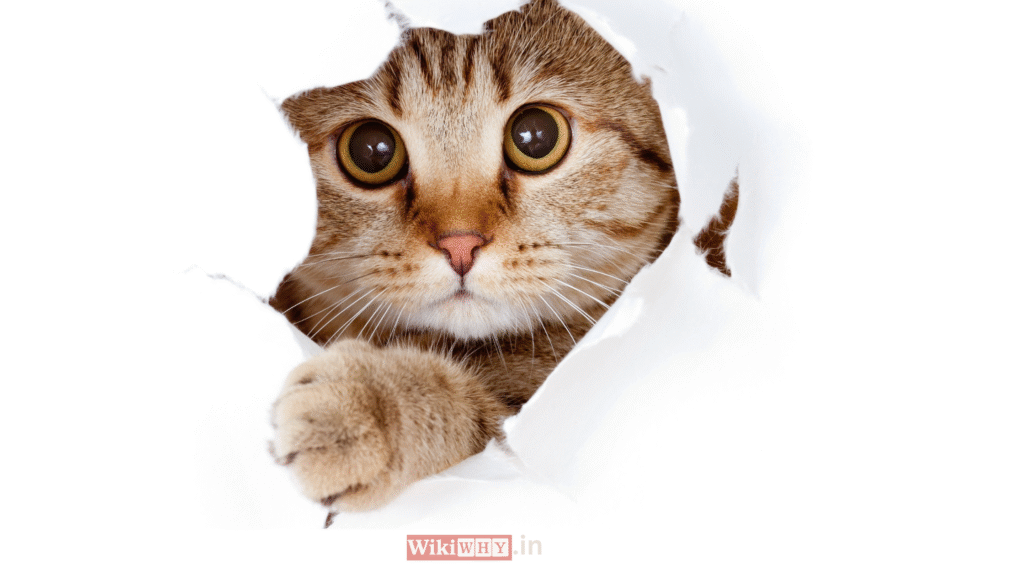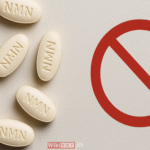Cats are normally quiet and clean animals. As cat owners, we notice everything about our cats from their playful attitudes to their litter box behavior.
We already discussed how heavy or rapid breathing in cats can signal something more serious that needs your attention.
So when something out of the ordinary appears, such as green poop, it’s understandable that you worry. If you find yourself wondering, “Why is my cat’s poop green?” you’re not alone.
This article will aid you in understanding the probable causes of green cat poop. We shall discuss what it implies, when it is normal, and when it’s necessary to consult the vet(veterinarian-an animal doctor). Let’s proceed with this strange but significant topic.
Is Green Cat Poop Normal?
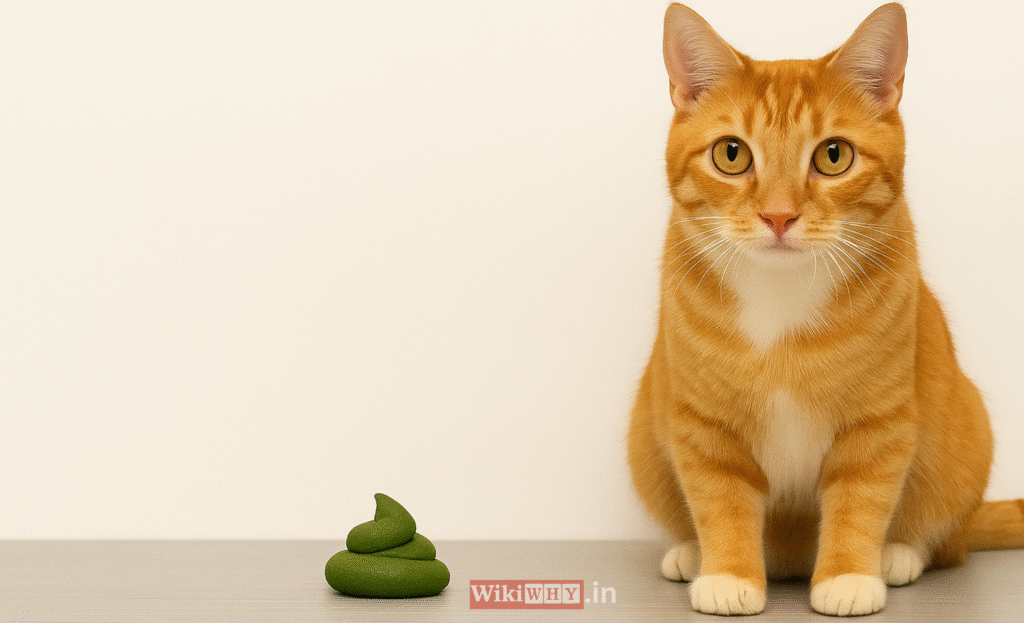
No, green kitty poop is not normal if it lasts for more than two days. Though, minor changes in color are natural due to diet or food, still, green stool could be an indication of something more dire.
What your cat’s poop color says about what’s happening in their digestive system:
If it’s green, it might indicate:
- A digestive issue
- A presence of bile not being broken down
- A side effect of what your cat ate
- An infection or sickness
Common Causes of Green Poop in Cats:
To help you to understand, let’s go over the most frequent reasons that provide the answer to the question:
Why is my cat’s poop green?
A. New Food or Food Coloring
Cats might respond to changes in the food. If you just introduced your cat to a new brand of food, particularly one with green colorings, that could be the cause.
Specifically, normal food causes:
- Green treats
- Cat grass
- Canned food with artificial color
Green-colored foods can move through your cat’s digestive tract without being completely absorbed. As a result, green color gets added in the poop.
Solution: To fix this, switch back to your cat’s normal diet. Meanwhile, observe whether the poop goes back to normal brown color within several days.
B. Grass or Plant Eating
Cats tend to eat grass or plants in the house. Some eat them to aid in digestion or induce vomiting if they have an upset stomach.
In some cases, if your cat is consuming a large amount of grass, the chlorophyll can make their stool green.
Be aware of:
- Over-eating plants
- Signs of diarrhea or vomiting
- Toxic plants (identify harmful ones in your house)
Solution: To stay safe, ensure that plants in your home are cat-safe and offer pet-safe grass if necessary.
C. Digestive Problems or Rapid Transit Time
One of the main causes of green poop is when food passes through the intestines too quickly. Consequently, when this occurs, bile doesn’t get time to fully break down.
What is bile?
What is bile?
Bile is a yellow-green liquid produced by the liver that enables fat to be digested.
Bile usually becomes brown-colored during digestion. If digestion is not given enough time, poop can appear green.
Possible causes:
- Stress
- Diarrhea
- Infections
- Food allergies
Solution: If green poop is loose or your cat is urinating more often, call your vet. It could be due to a gastrointestinal problem.
D. Intestinal Parasites
Parasites or worms can disturb your cat’s gut. This might result in symptoms such as:
- Green poop
- Diarrhea
- Weight loss
- Vomiting
- Normal parasites in cats:
- Roundworms
- Hookworms
- Giardia
Solution: Your vet can perform a fecal test and give appropriate deworming treatment.
E. Liver or Gallbladder Problems
The liver and gallbladder are also important to digestion. When these organs are not functioning, they can influence how bile is utilized.
Green stool may be one of the first signs of liver issues, particularly when it occurs with:
- Yellowing of the eyes (jaundice)
- Weakness
- Loss of appetite
Solution: A veterinarian examination and lab work are required to evaluate liver function.
F. Bacterial Infections
Sometimes green poop is caused by bacteria in the gut. Infections can cause inflammation and lead to unusual poop colors.
Signs of a possible infection:
- Fever
- Lethargy
- Diarrhea with mucus or blood
- Vomiting
Solution: Seek vet care immediately. Your cat may need antibiotics or supportive fluids.
When to Worry About Dark Green Cat Poop?
If you notice green poop one time and your cat is otherwise normal, it may not be anything to worry about. However, repeated green stool or other symptoms cannot be dismissed.
In that case, contact your vet if:
- Green poop persists for longer than 2 days
- Your cat is lethargic or weak
- There is blood or mucus present in the stool
- Your cat is vomiting or won’t eat
- You see unexplained weight loss
- Early treatment can also prevent severe illness.
How to Diagnose the Cause?
Your vet might recommend one or more of the following tests to determine why your cat’s poop is green:
- Fecal test (to see if there are parasites or bacteria)
- Blood work (to examine liver and organ function)
- X-rays or ultrasound (to look at internal organs)
- Diet trial (to eliminate allergies or intolerances)
Afterward, once the cause is determined, treatment can start.
Treatment Options
The appropriate treatment varies based on the reason. Here’s what your vet may recommend:
| Cause | Treatment |
| Food/Diet | Go back to normal diet, skip dyes |
| Parasites | Deworming drugs |
| Infections | Antibiotics and IV fluids |
| Liver issues | Special diet, liver support drugs |
| Fast digestion | Diet adjustment, probiotics, fluids |
Note: Never administer human medicine or over-the-counter medication to your cat without the vet’s approval.
How to Prevent Green Poop in Cats
Prevention is always better than cure. Here’s how to maintain healthy digestion in your cat:
A. Feed a Consistent Diet
Don’t change foods often. Use high-quality cat food that doesn’t have artificial coloring.
B. Out of Reach for Houseplants
Only use cat-safe houseplants. Lilies, aloe vera, and philodendron are poisonous to cats.
C. Regular Deworming
Take your vet’s recommendations on parasite prevention.
D. Stress Watch
Routines changed, new pets, or trips can cause your cat’s stomach upset. Maintain a stable and calm environment.
E. Litter Box Habit Watch
Inspect the litter box every day. Color, shape, or smell changes in poop can be warning signs of illness.
Can Kittens Have Green Poop Too?
Yes, kittens can also have green poop, and it’s usually more serious. Their immune systems are still developing, so they are more at risk.
In kittens, green poop can mean:
- A parasite infection
- A reaction to formula or milk
- Rapid digestion or diarrhea
- Bacterial infection
Note: If a kitten develops green stool, seek a vet at once. Kittens dehydrate fast.
7. Natural Treatments for Mild Cases
If your cat otherwise seems healthy and the green poop is not bad, these are some natural choices:
- Pumpkin puree: Fibers and digestion assistance.
- Plain boiled chicken: Easy on the stomach.
- Probiotics: Gut support (check with your vet first).
- Hydration: Ensure your cat stays hydrated with plenty of water.
These should not replace vet care but may support mild tummy upsets.
What Your Cat’s Poop Color Reveals about Their Health
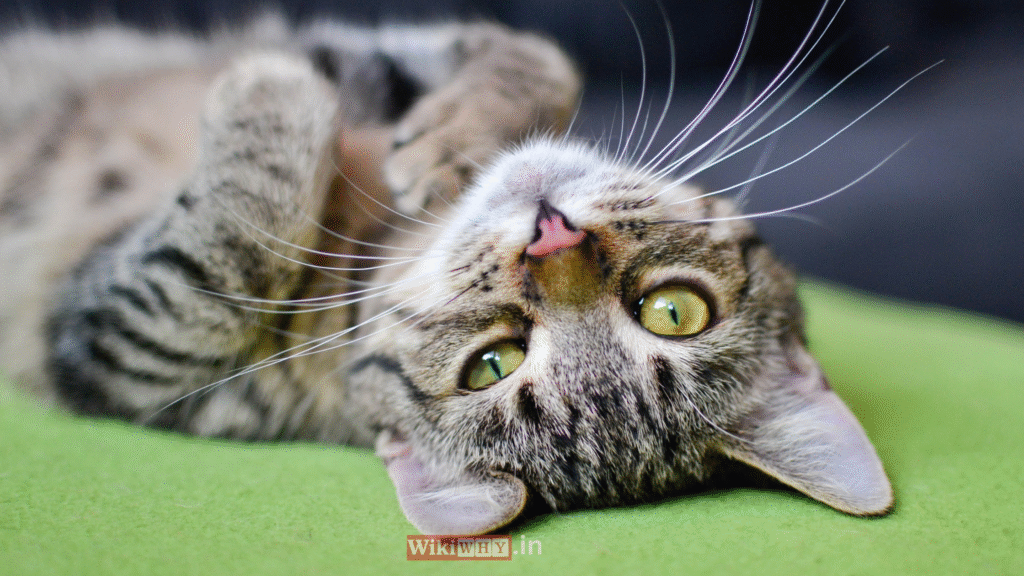
Similar to humans, the color of your cat’s poop may provide some very important hints about what is going on inside their body.
Though we tend to ignore the litter box, paying attention to the color of your cat’s stool can assist you in catching health issues early.
Below is what various poop colors in cats may reveal:
1. Brown Poop (Normal)
Normal cat poop is typically a deep, chocolate brown. This indicates that your cat is properly digesting food and all is well in the digestive tract.
- Not hard, but firm
- Odorless
- Same size and shape every time
This is what you should be seeing in the litter box.
2. Green Poop
As discussed in great detail above, green poop is abnormal and may be due to:
- Fast digestion (bile not completely digested)
- Munching grass or green-colored food
- Parasites or infection
- Liver or gallbladder disease
If it lasts longer than 48 hours or is accompanied by other symptoms, see your vet.
3. Black or Very Dark Poop
Dark black or tarry stool is usually worrying. It usually means there is digested blood present, which can be indicative of:
- Stomach ulcers
- Internal bleeding in the upper digestive system
- Swallowing something toxic
- This is an emergency. Don’t wait to go to the vet.
4. Red or Bloody Poop
Fresh red blood in your cat’s stool might look like streaks or spots. This can be due to:
- Anal gland problems
- Constipation and straining
- Intestinal trauma
- Infection or parasites
- Bloody stool is never normal and must always be checked by a vet.
5. Yellow or Pale Stool
Yellow-colored stool or very light-colored poop may be related to liver, pancreas, or gallbladder issues. They disrupt bile production, which is what gives the stool its usual brownish color.
In cats, yellow stool also might signal infection or intolerance to milk formula.
6. Gray or Greasy Stool
Gray, greasy-colored poop tends to be associated with impaired digestion of fat. This may be caused by:
- Pancreatic insufficiency
- Diets high in fat
- Malabsorption disorders
This stool tends to have a bad odor and might need enzyme supplements or a change in diet.
7. White Specks in Stool
White speck-like particles in cat feces typically indicate the presence of tapeworms. The parasites link to your cat’s intestines and expel segments onto the stool.
Treatment involves a good deworming medication from your vet.
If you’re not sure what a specific shade or consistency is indicating, snap a photo and consult with your veterinarian for guidance.
Understand, What Your Cat’s Poop is Telling About Its Health.
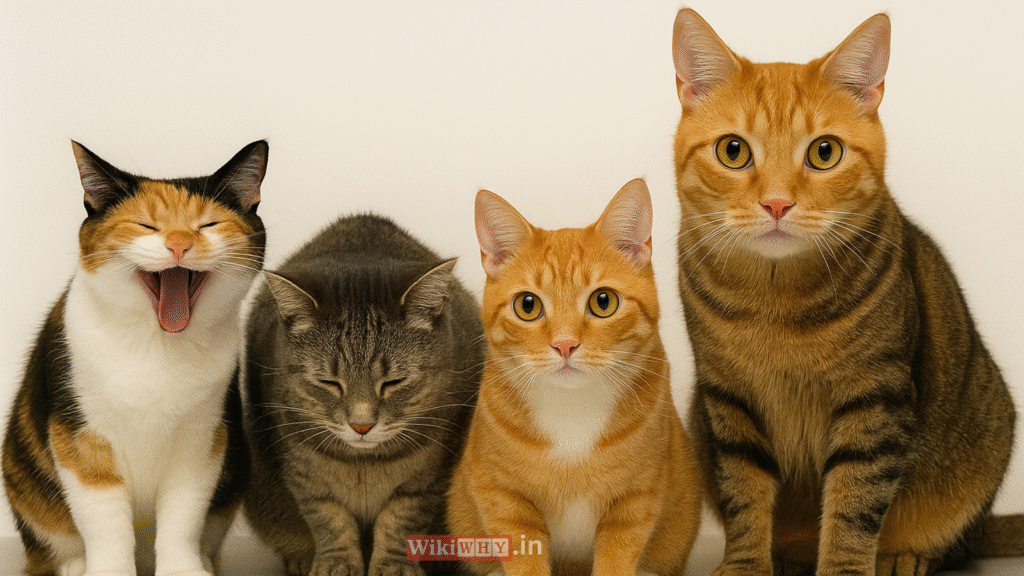
Quick Poop Color Guide For Smart Pet Parent :
| Poop Color | Meaning |
| Brown | Normal and healthy |
| Green | Bile, grass, food dye, infection |
| Black | Digested blood, internal bleeding |
| Red | Fresh blood, injury, parasite |
| Yellow | Liver/gallbladder/pancreatic issue |
| Gray | Fat digestion issue |
| White specks | Tapeworms or other parasites |
By understanding what your cat’s poop color tells you, you’re one step closer to being a more informed and attentive pet parent.
Final Thoughts:
If you’ve been wondering, “Why is my cat’s poop green?”, because—something is off with digestion. It might be as simple as a food change, or something more serious like a liver issue or parasite.
Green stool is a warning sign. It’s how your cat’s trying to tell you that something is amiss. Always pay attention to their behavior as well as stool variations, and never hesitate to consult with a vet if you’re unsure.
Your cat is counting on you to catch changes and act accordingly.
Your cat relies on you to notice changes and respond accordingly. By paying attention and educating yourself, you’re giving your pet the best care.
Key Takeaways:
- All in all Green stool(waste products from body) in cats is abnormal and could be an indication of gastrointestinal issues.
- Causes can vary from food and grass to infections or liver disease.
- Monitor for other signs such as vomiting, diarrhea, or lethargy.
- If unsure, always call on your vet for guidance and treatment.
Common Questions Answered
Q1. Why is my cat’s poop green?
Green poop in cats usually means food is moving too quickly through the intestines, or your cat ate something with green coloring (like grass, leafy veggies, or even food dye). Sometimes it’s harmless, but it can also point to tummy troubles or infection.
Q2. Can what my cat eats cause green poop?
Yes, absolutely. Grass, spinach, or even some cat treats with coloring can make poop look green. A sudden food change can also upset your cat’s stomach and change stool color.
Q3. Should I worry if my cat’s poop is green?
If it happens just once, and your cat seems fine otherwise, it’s usually nothing to stress about. But if it continues for more than a day or two, or your cat is also vomiting, refusing food, or acting sick, it’s time to call the vet.
Q4. Can parasites or illness make cat poop green?
Yes. Worms, stomach infections, or even liver problems can sometimes cause green or yellow-green poop. A vet check and stool test are the only way to know for sure.
Q5. What can I do at home if I see green poop?
• Keep an eye on your cat’s litter box for changes.
• Make sure they have plenty of fresh water.
• Don’t change foods suddenly — do it slowly if needed.
• If it’s just a one-time thing, you can wait and watch.
But if the green poop keeps coming back or your cat looks unwell, head to the vet.
Q6. Does green poop always mean something is wrong?
Not always. Sometimes it’s just food or grass. But since poop color can also hint at health problems, it’s safer to keep an eye on it and get help if it doesn’t go away.

